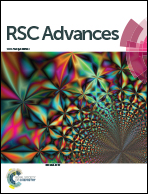Non-isothermal crystallization kinetics, thermal degradation behavior and mechanical properties of poly(lactic acid)/MOF composites prepared by melt-blending methods
Abstract
In this article, poly(lactic acid)/metal–organic framework composites were prepared by melt-blending methods and the effects of MOFs on the non-isothermal crystallization, thermal degradation and mechanical property of poly(lactic acid) (PLA) were studied by differential scanning calorimetry (DSC), thermogravimetric analyses (TGA) and tensile testing, respectively. The Jeziorny and Mo methods were applied to describe the kinetics of the non-isothermal crystallization process. The results demonstrated that the presence of MOFs accelerated the crystallization rate and increased the crystallinity (Xc) of the PLA/MOF composites. The XRD results confirmed that the addition of MOFs decreased the crystallite size of PLA. The TGA results indicated that MOFs increased the initial thermal degradation temperature of PLA and decreased the thermal stability at high temperature regions. The tensile strength of PLA was increased from 66.23 MPa to 92.44 MPa, 96.03 MPa and 95.25 MPa with MOF loadings of 0.5 wt%, 1 wt% and 1.5 wt%, respectively, but the strain at break was decreased.


 Please wait while we load your content...
Please wait while we load your content...